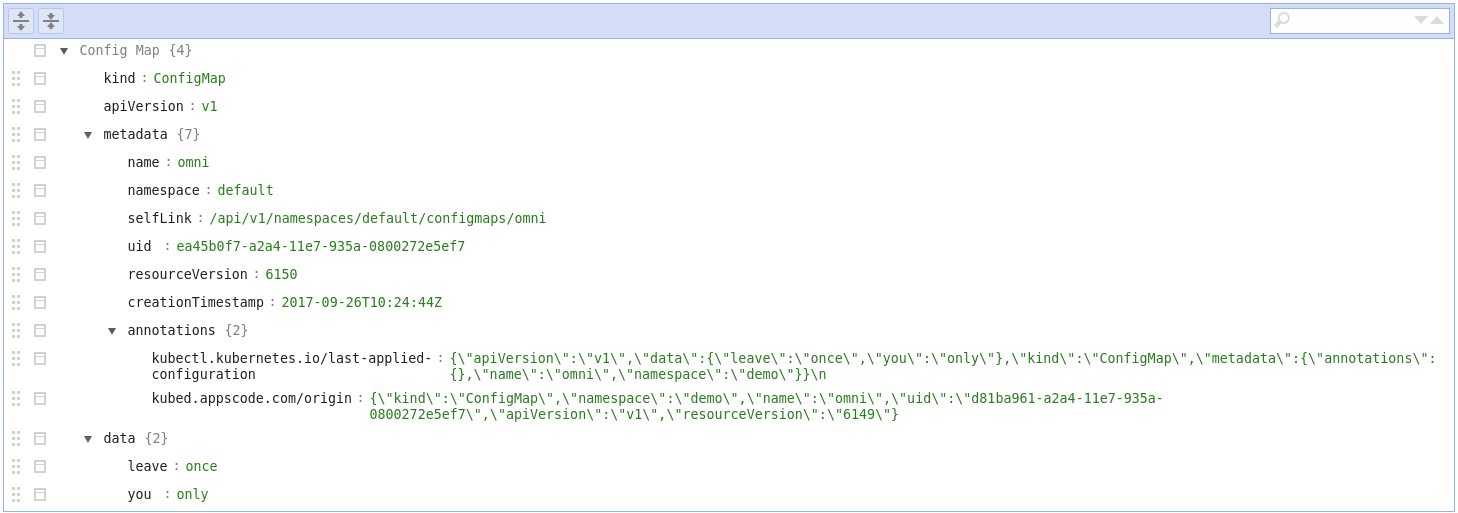You are looking at the documentation of a prior release. To read the documentation of the latest release, please
visit here.
New to Kubed? Please start here.
Synchronize Configuration across Namespaces
Say, you are using some Docker private registry. You want to keep its image pull secret synchronized across all namespaces of a Kubernetes cluster. Kubed can do that for you. If a ConfigMap or a Secret has the annotation kubed.appscode.com/sync:true, Kubed will create a copy of that ConfigMap / Secret in all existing namespaces. Kubed will also create this ConfigMap/Secret, when you create a new namespace. If the data in the source ConfigMap/Secret is updated, all the copies will be updated. Either delete the source ConfigMap/Secret or remove the annotation from the source ConfigMap/Secret to remove the copies. If the namespace with the source ConfigMap/Secret is deleted, the copies are left intact.
Before You Begin
At first, you need to have a Kubernetes cluster, and the kubectl command-line tool must be configured to communicate with your cluster. If you do not already have a cluster, you can create one by using Minikube.
Deploy Kubed
To enable config syncer, you need a cluster config like below.
$ cat ./docs/examples/config-syncer/config.yaml
enableConfigSyncer: true
| Key | Description |
|---|---|
enableConfigSyncer | Required. If set to true, ConfigMap/Secret synchronization operation will be enabled. |
Now, create a Secret with the Kubed cluster config under config.yaml key.
$ kubectl create secret generic kubed-config -n kube-system \
--from-file=./docs/examples/config-syncer/config.yaml
secret "kubed-config" created
# apply app=kubed label to easily cleanup later
$ kubectl label secret kubed-config app=kubed -n kube-system
secret "kubed-config" labeled
$ kubectl get secret kubed-config -n kube-system -o yaml
apiVersion: v1
data:
config.yaml: ZW5hYmxlQ29uZmlnU3luY2VyOiB0cnVlCg==
kind: Secret
metadata:
creationTimestamp: 2017-07-26T10:25:33Z
labels:
app: kubed
name: kubed-config
namespace: kube-system
resourceVersion: "25114"
selfLink: /api/v1/namespaces/kube-system/secrets/kubed-config
uid: c207c236-71ec-11e7-a5ec-0800273df5f2
type: Opaque
Now, deploy Kubed operator in your cluster following the steps here. Once the operator pod is running, go to the next section.
Synchronize ConfigMap
In this tutorial, a ConfigMap will be synced across Kubernetes namespaces using Kubed. You can do the same using Secrets.
To keep things isolated, this tutorial uses a separate namespace called demo throughout this tutorial. Run the following command to prepare your cluster for this tutorial:
$ kubectl create namespace demo
namespace "demo" created
~ $ kubectl get namespaces
NAME STATUS AGE
default Active 6h
kube-public Active 6h
kube-system Active 6h
demo Active 4m
Now, create a ConfigMap called omni in the demo namespace. This will be our source ConfigMap.
$ kubectl apply -f ./docs/examples/config-syncer/demo-0.yaml
configmap "omni" created
$ kubectl get configmaps --all-namespaces | grep omni
demo omni 2 7m
$ kubectl get configmaps omni -n demo -o yaml
apiVersion: v1
data:
you: only
leave: once
kind: ConfigMap
metadata:
annotations:
kubectl.kubernetes.io/last-applied-configuration: |
{"apiVersion":"v1","data":{"leave":"once","you":"only"},"kind":"ConfigMap","metadata":{"annotations":{},"name":"omni","namespace":"demo"}}
creationTimestamp: 2017-07-26T13:20:15Z
name: omni
namespace: demo
resourceVersion: "10598"
selfLink: /api/v1/namespaces/demo/configmaps/omni
uid: 2988e9d5-7205-11e7-af79-08002738e55e
Now, apply the kubed.appscode.com/sync: true annotaiotn to ConfigMap omni. Kubed operator will notice that and copy the ConfigMap in all existing namespaces.
$ kubectl annotate configmap omni kubed.appscode.com/sync=true -n demo
configmap "omni" annotated
$ kubectl get configmaps --all-namespaces | grep omni
default omni 2 1m
demo omni 2 8m
kube-public omni 2 1m
kube-system omni 2 1m
$ kubectl get configmaps omni -n demo -o yaml
apiVersion: v1
data:
you: only
leave: once
kind: ConfigMap
metadata:
annotations:
kubectl.kubernetes.io/last-applied-configuration: |
{"apiVersion":"v1","data":{"leave":"once","you":"only"},"kind":"ConfigMap","metadata":{"annotations":{},"name":"omni","namespace":"demo"}}
kubed.appscode.com/sync: "true"
creationTimestamp: 2017-07-26T13:20:15Z
name: omni
namespace: demo
resourceVersion: "11053"
selfLink: /api/v1/namespaces/demo/configmaps/omni
uid: 2988e9d5-7205-11e7-af79-08002738e55e
Now, create a new namespace called other. Kubed will copy ConfigMap omni into that namespace.
$ kubectl create ns other
namespace "other" created
$ kubectl get configmaps --all-namespaces | grep omni
default omni 2 5m
demo omni 2 12m
kube-public omni 2 5m
kube-system omni 2 5m
other omni 2 1m
Alas! there is a typo is the ConfigMap data. Let’s fix that.
$ kubectl apply -f ./docs/examples/config-syncer/demo-1.yaml
configmap "omni" configured
$ kubectl get configmaps --all-namespaces | grep omni
default omni 2 9m
demo omni 2 16m
kube-public omni 2 9m
kube-system omni 2 9m
other omni 2 5m
$ kubectl get configmaps omni -n other -o yaml
apiVersion: v1
data:
you: only
live: once
kind: ConfigMap
metadata:
annotations:
kubectl.kubernetes.io/last-applied-configuration: |
{"apiVersion":"v1","data":{"live":"once","you":"only"},"kind":"ConfigMap","metadata":{"annotations":{},"name":"omni","namespace":"demo"}}
creationTimestamp: 2017-07-26T13:31:13Z
name: omni
namespace: other
resourceVersion: "11594"
selfLink: /api/v1/namespaces/other/configmaps/omni
uid: b193f40f-7206-11e7-af79-08002738e55e
Kubed operation notices that the source ConfigMap omni has been updated and propagated the change to all the copies in other namespaces.
Now, lets’ remove the annotation from source ConfigMap omni. Please note that - after annotation key kubed.appscode.com/sync-. This tells kubectl to remove this annotation from ConfigMap omni.
$ kubectl annotate configmap omni kubed.appscode.com/sync- -n demo
configmap "omni" annotated
$ kubectl get configmaps --all-namespaces | grep omni
demo omni 2 18m
Origin annotation
Since 0.3.1, kubed operator will apply kubed.appscode.com/origin annotation on ConfigMap or Secret copies.

Disable Syncer
If you would like to disable this feature, either remove the enableConfigSyncer field in your Kubed cluster config or set enableConfigSyncer to false. Then update the kubed-config Secret and restart Kubed operator pod(s).
Cleaning up
To cleanup the Kubernetes resources created by this tutorial, run the following commands:
$ kubectl delete ns other
namespace "other" deleted
$ kubectl delete ns demo
namespace "demo" deleted
To uninstall Kubed operator, please follow the steps here.
Next Steps
- Learn how to use Kubed to take periodic snapshots of a Kubernetes cluster here.
- To setup a recycle bin for deleted and/or updated Kubernetes objects, please visit here.
- Want to keep an eye on your cluster with automated notifications? Setup Kubed event forwarder.
- Out of disk space because of too much logs in Elasticsearch or metrics in InfluxDB? Configure janitors to delete old data.
- See the list of supported notifiers here.
- Wondering what features are coming next? Please visit here.
- Want to hack on Kubed? Check our contribution guidelines.









